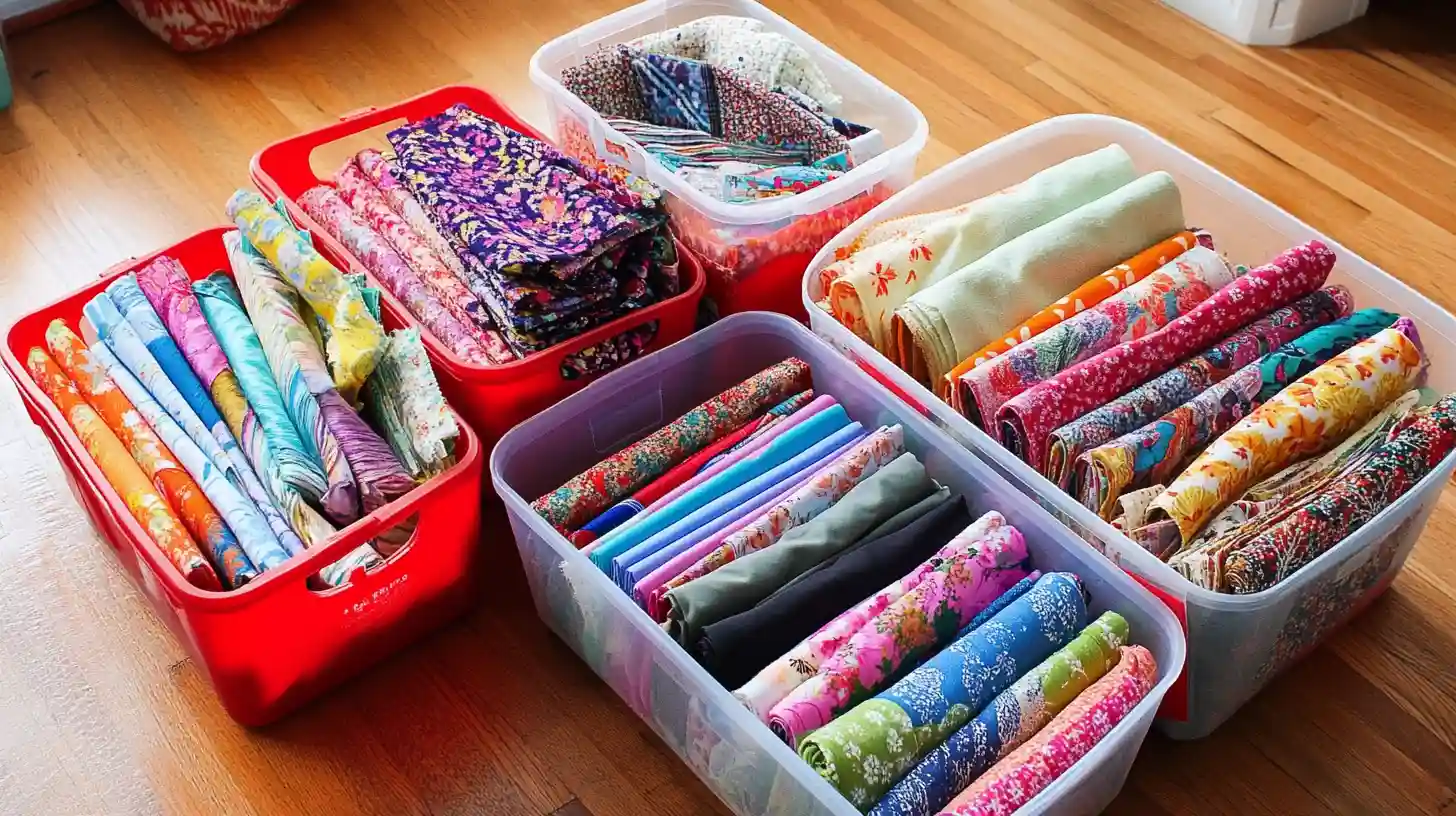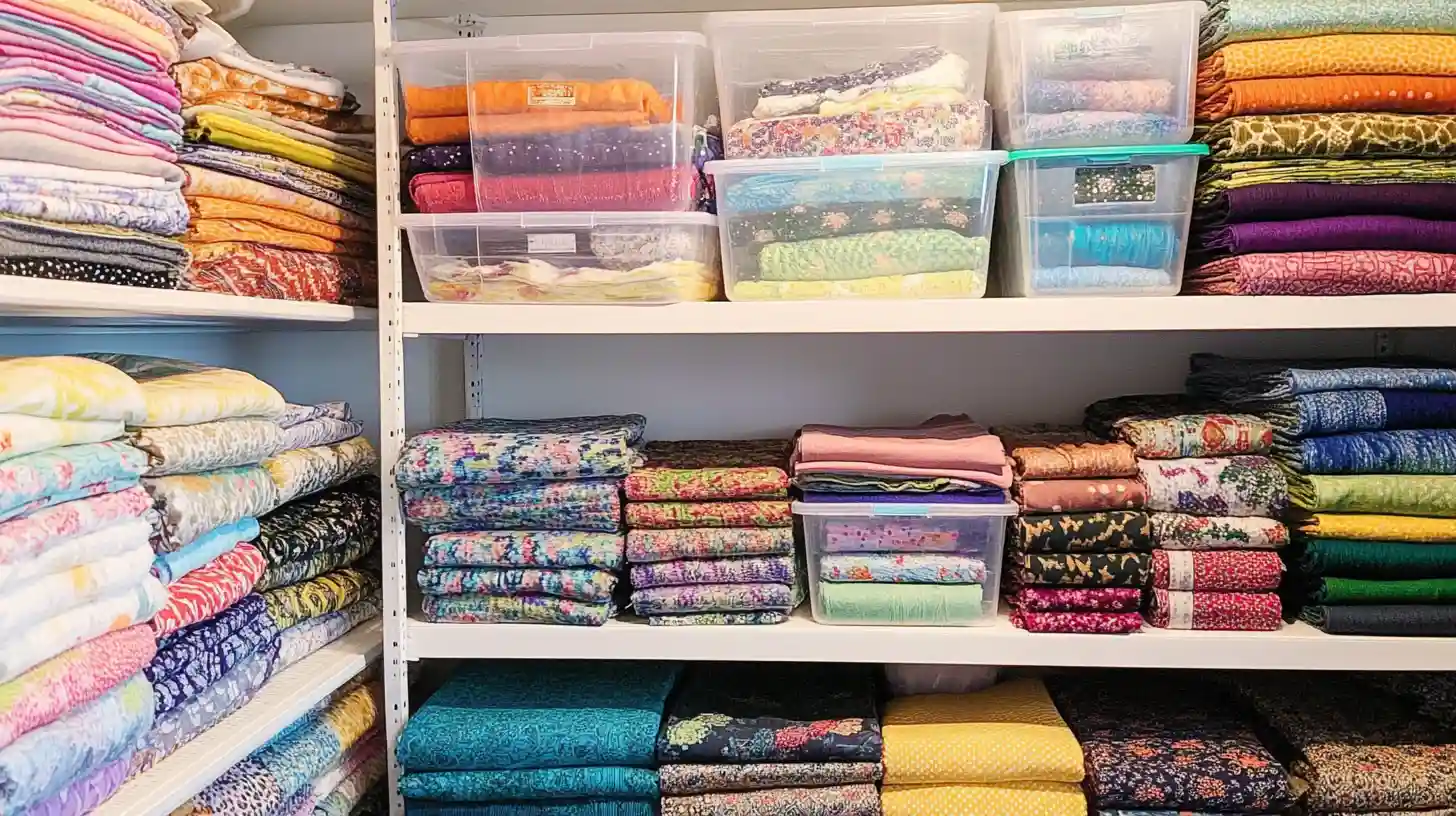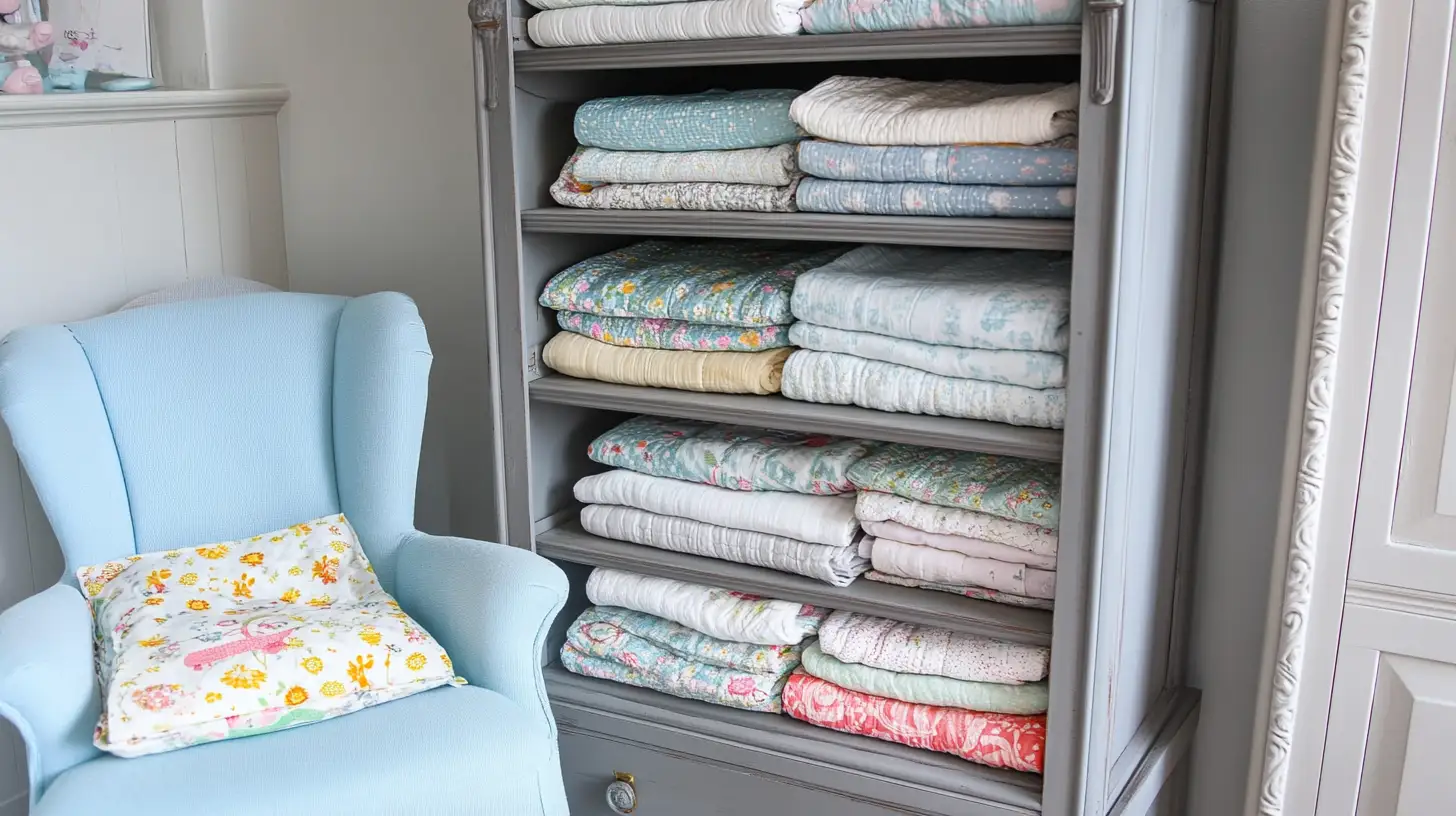Are you a creative soul with a passion for sewing and crafting? If so, you know that fabric scraps can accumulate quickly, often leaving you wondering how to keep them organized and accessible.
Fear not! With a little inspiration and some clever storage solutions, you can transform your fabric remnants into a treasure trove of creativity.
This guide explores 5 effective ways to store your fabric scraps, ensuring that every piece is ready to spark your next project. Let's dive in and unleash your inner designer!
Key Takeaways
- Sort and store scraps by size, color, and material for efficient organization.
- Use clear plastic bins to protect and easily identify fabric scraps.
- Use drawer organizers or ziplock bags for compartmentalized storage.
- Use vertical space with pegboards and hanging storage solutions.
- Regularly assess and declutter to maintain order and usability of scraps.
Step 1: Assess Your Fabric Scraps

Start by gathering all your fabric scraps into one place and assess their condition.
Sort by Size
When sorting your fabric scraps, organizing them by size can make a world of difference.
By sorting by size, you can quickly find the right pieces for your projects. Common sizes include large chunks, medium squares, and small crumbs. You can also cut scraps into standard sizes like fat eighths or 2.5 x 2.5 squares for sorting.
Keeping your scraps sorted into these categories helps streamline your workflow and enhances your storage system's efficiency.
Sort by Material
Beyond sorting your fabric scraps by size, you can also categorize them by material.
Start by separating quilting cotton scraps from non-quilting cottons like canvas or denim. Keep larger pieces separate for easier access.
Recognize different fabric types, such as knits and wovens, to maintain an organized scrap collection.
Regularly assess and purge to ensure functionality and organization.
Sort by Color
Sorting your fabric scraps by color not only enhances accessibility but also injects a sense of order into your crafting space.
Start by sorting scraps organized into warm and cool color groups for smaller collections. For larger collections, sort by color individually. Designate multi-colored fabrics as their own category.
Regularly reassess your fabric scraps to keep your storage area tidy and inspiring.
Step 2: Choose the Right Storage Solutions

There are various effective storage solutions for your fabric scraps.
1. Clear Plastic Bins
Clear plastic bins are a fantastic choice for storing your fabric scraps. They offer the perfect blend of visibility and protection.
These storage bins keep your scraps organized and easy to find. Opt for stackable bins to maximize your vertical space.
2. Fabric Baskets
While clear plastic bins are great for visibility and protection, fabric baskets offer a stylish and practical alternative for storing your fabric scraps.
Use fabric baskets made from breathable materials to prevent moisture damage. Implement organizing ideas like color coding to streamline your workflow.
Choose baskets of various sizes and shapes to store scraps efficiently. Remember to consider handles for easy portability.
3. Ziplock Bags
Ziplock bags let you efficiently organize fabric by categorizing scraps by color or size. Use larger bags for bulkier pieces and smaller ones for tiny scraps.
Label each bag for easy retrieval. Stack or store your scraps in bins to keep them protected and accessible.
4. Drawer Organizers
Why let fabric scraps clutter your workspace when drawer organizers can keep everything neatly contained and easily accessible?
Use drawer organizers with compartments to store usable scraps, like quilting cotton.
Shallow drawers help prevent creasing and make viewing easier.
Label each section to quickly sort my scraps, ensuring efficient fabric storage.
Regularly reassess to accommodate new materials.
5. Hanging Storage
To optimize your sewing room, consider integrating hanging storage solutions. These solutions maximize vertical space while keeping fabric scraps visible and accessible.
Use clear plastic pockets or shoe organizers to keep your scraps organized by color.
Hang fabric strips on curtain rods, and use mesh bags for smaller scraps.
Step 3: Organize Your Fabric Scraps

To keep your fabric scraps neat and accessible, let's learn some tips for organizing them effectively.
Labeling Systems
A well-designed labeling system keeps your fabric scraps organized and easily accessible.
Use clear labels to ensure quick identification without opening containers. Organize scraps sorted by color using a consistent color-coding scheme.
Label larger scraps with their dimensions for quick size identification. Regularly update your labels as your collection evolves to maintain an efficient and visually appealing system.
Folding and Rolling Techniques
Folding and rolling techniques can enhance storage efficiency when organizing fabric scraps.
Fold fabric scraps into neat rectangles to reduce wrinkles and maximize space. Rolling scraps into tubes saves space and allows quick access. Both methods prevent fraying and damage, ensuring your fabric is ready for future projects.
Consistent folding sizes, like 6x9 inches, standardize storage in bins or drawers.
Use Vertical Space
Maximizing vertical space can revolutionize your fabric scrap storage. This allows you to keep your workspace tidy and efficient.
Use vertical storage solutions like stacking bins and wall-mounted storage. Tall, clear containers help you see what's inside, while pegboards and hanging baskets make retrieval quick.
This approach not only saves floor space but also boosts your productivity.
Step 4: Maintain Your Fabric Scrap Storage
To keep your fabric scrap storage efficient, regularly declutter your collection and keep an inventory log for easy tracking.
Clean and refresh your storage area, preventing dust buildup.
Regular Decluttering
Regularly declutter your fabric scraps to maintain a tidy and inspiring crafting space.
Regularly review and declutter your scraps to remove uninspiring pieces, making room for new materials. Establish a monthly schedule for organizing fabric, creating donation piles to streamline the process.
This prevents clutter from accumulating and keeps your scrap storage efficient and manageable
Keep an Inventory Log
Keeping an inventory log is a practical next step to maintain an organized crafting space.
Start by categorizing your scraps by color, size, and type. Regularly update your inventory log after each project.
Consider using a digital system to streamline updates and access your log from multiple devices. This method enhances organization and helps track your fabric scraps effectively.
Keep Scraps Clean and Fresh
Anyone looking to keep their fabric scraps clean and fresh needs to focus on proper storage techniques.
Properly store fabric scraps to keep them dust-free. Use breathable fabric bags to prevent moisture buildup, ensuring they stay clean and fresh.
Regularly rotate older scraps to prevent deterioration. Place containers in shaded areas to avoid fading from sunlight exposure.
Additional Creative Storage Ideas

You can get creative with storage by using mason jars, repurposing old furniture, and using pegboards and hooks.
Glass Jars and Mason Jars
Glass jars and mason jars are excellent ways to store your small fabric scraps.
You can easily categorize scraps by color or type using different jar sizes. The clear glass jars make it simple to see your inventory at a glance, while also protecting the fabric from dust.
This method keeps your crafting space organized and charming.
Repurposed Furniture
Transforming repurposed furniture into storage solutions for fabric scraps can add both functionality and charm to your crafting space.
Use old dressers to categorize and organize materials by color or type. Vintage suitcases offer a charming way to save scraps dust-free.
Stack wooden crates to create unique shelving units, maximizing vertical space. Repurposed bookshelves with clear bins keep your fabric scraps organized and visible.
Pegboards and Hooks
Pegboards frequently offer a versatile and customizable solution for storing fabric scraps. They make your space both practical and visually appealing.
Use hooks to hang various sizes and types of fabric scraps, ensuring easy access and optimal organization.
Color-coded bins or small baskets on pegboards enhance storage and keep your workspace tidy.
This system prevents wrinkles and adapts to your project's changing needs.
Creative Uses for Fabric Scraps
Now that your fabric scraps are organized, let's explore some exciting ways to use them creatively.
- Patchwork quilts: Combine various scrap fabrics to create a unique and colorful scrappy quilt.
- Appliqué designs: Add decorative shapes or patterns to clothing, bags, or home decor items.
- Fabric bookmarks: Sew small pieces together to create sturdy bookmarks.
- Scrunchies: Use fabric scraps to make stylish hair accessories.
- Mug rugs or coasters: Stitch together small fabric pieces for practical table protectors.
- Keychains: Create mini fabric keychains with your fabric stash.
- Toy stuffing: Use scraps as filling for homemade plush toys.
- Fabric flowers: Craft decorative flowers that can be used as brooches or hair clips.
- Gift wrap: Wrap small gifts in fabric scraps for an eco-friendly option.
- Bunting: Sew triangles of fabric onto a string to make festive bunting.
- Pockets: Add extra pockets to clothing or bags using fabric scraps.
- Reusable makeup remover pads: Make washable pads for an eco-friendly alternative to disposable ones.
- Pet toys: Create simple toys for pets using durable scrap quilting cotton.
- Lavender sachets: Fill small fabric pouches with dried lavender for a fragrant drawer freshener.
- DIY face masks: Sew face masks from leftover fabric pieces.
Conclusion: How to Store Fabric Scraps
With these tips, you'll keep your fabric scraps organized and accessible. Start by sorting your scraps, then choose the right storage solutions. Label everything for easy identification and regularly assess your collection to keep it tidy.
By maintaining an organized system, you'll always have your fabric scraps ready for your next creative project. Happy crafting!
Learn more fabric knowledge on the Longan Craft Blog, and dive into the fabric world with Longancraft!
FAQs
How Best to Store Fabric Scraps?
You should categorize your fabric scraps by color, size, or type. Use clear bins or resealable bags for easy access. Keep your storage area clean and regularly declutter. This will protect your fabric and maintain an organized space.
How Do You Deal With Fabric Scraps?
You should categorize and store your fabric scraps by size and color in clear bins. Regularly assess and declutter your collection. Pre-cut scraps into common sizes and rotate older pieces to keep your crafting space organized and efficient.
How to Store Small Amounts of Fabric?
You can store small amounts of fabric by using resealable bags, clear jars, or decorative baskets. Categorize scraps by color or type, and keep them visible and accessible. Use vertical space with hanging organizers for maximum efficiency.
How Do You Store Large Pieces of Fabric?
To store large fabric pieces, roll them onto cardboard bolts or fabric rolls. Use clear bins, labeled drawers, or wall-mounted racks for easy access. Keep them neatly folded in dedicated storage to prevent wrinkles and damage.


0 comments